Digital Posters
Innovative Transmit Coils
ISMRM & SMRT Annual Meeting • 15-20 May 2021

| Concurrent 2 | 19:00 - 20:00 |
1571.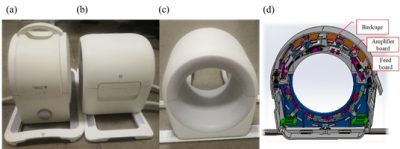 |
Design and evaluation of a 2-Tx 24-Rx coil for 5T knee MR imaging
Shao Che1, Junjun Qin1, Shihong Han1, and Ye Li2
1United Imaging Healthcare, Shanghai, China, 2Lauterbur Imaging Research Center, Shenzhen Institutes of Advanced Technology, Chinese Academy of Science, Shanghai, China
Musculoskeletal imaging is one widely used MR application with advantages in exquisite details of anatomic structure, rich contrast options for various soft tissues and high diagnostic accuracy [1]. The SNR gain of high field MRI can further help extending such applications as magnetic resonance knee imaging. A 2-channel birdcage transmit and 24-channel loop array receive coil is designed and evaluated on the novel whole body 5T MRI scanner (United Imaging Healthcare, Shanghai, China, abbreviated as UIH below). The imaging performance is compared with a 3T scanner and the results are discussed.
|
|||
1572.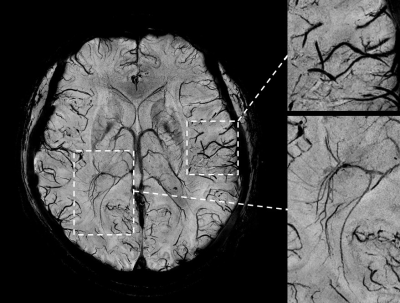 |
In-vivo human brain imaging at 5 T using a 48 channel Tx-Rx array
Ye Li1,2, Zidong Wei1,2,3, Shihong Han3, Shuheng Zhang3, Qiang He3, Xiaoliang Zhang4, Xin Liu1,2, and Hairong Zheng1,2
1Lauterbur Imaging Research Center, Shenzhen Institutes of Advanced Technology, Chinese Academy of Sciences, Shenzhen, China, 2Key Laboratory for Magnetic Resonance and Multimodality Imaging of Guangdong Province, Shenzhen, China, 3United Imaging Healthcare, Shanghai, China, 4Department of Biomedical Engineering, State University of New York at Buffalo, NY, NY, United States
Intermediate field strength between 3 T and 7 T may provide significant signal-to-noise ratio improvement but with less radio frequency challenges. In this work in-vivo human brain images including anatomic images, angiography images and susceptibility weighted images have been acquired at a prototype 5 T whole body scanner using a 48 channel Tx-Rx array, and compared with those at 3 T commercial scanner. Significant signal-to-noise ratio improvement of 5 T has been shown while image homogeneity is still acceptable.
|
|||
1573. |
An 8-channel transmit loop array for body imaging at 5T
Fuyi Fang1, Wei Luo1, Jingxia Gong1, Rongxing Zhang1, Zidong Wei2, and Ye Li2
1United Imaging Healthcare, Shanghai, China, 2Lauterbur Imaging Research Center, Shenzhen Institutes of Advanced Technology, Chinese Academy of Sciences, Shenzhen, China In this study, an 8-channel (8ch) loop and a 2-channel (2ch) birdcage in 5T frequency are built and compared. Basic electrical characteristics, engineering issues in implementation, transmitting efficiency, perturbation sensitivity, B1+ uniformity and local SAR are compared between these two coils. Measurement result of the B1+ distribution in torso region with these coils are obtained from a whole body 5T MRI scanner.
|
|||
1574.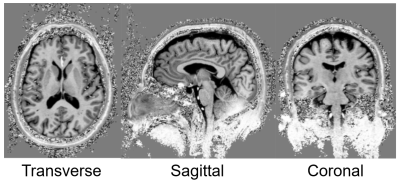 |
Robust decoupling of a 7 Tesla 8-channel loop array for head and cervical spinal cord imaging
Bei Zhang1, Abbas Zaki2, Daniel Lowrance2, Ivan Dimitrov1,3, Binu Thomas1, Andreas Pfrommer4, and Anke Henning1,4
1Advanced Imaging Research Center, University of Texas Southwestern Medical Center, Dallas, TX, United States, 2Erik Jonsson School of Engineering and Computer Science at The University of Texas at Dallas, Richardson, TX, United States, 3Philips Healthcare, Gainesville, FL, United States, 4Max Planck Institute for Biological Cybernetics, Tuebingen, Germany
With the guidance of our in-house analytical modeling tool that was developed originally for minimizing both electrical coupling and magnetic coupling , we designed a 7T 8-channel T/R array with robust decoupling performance for both head and cervical spinal cord imaging, and our 7T 8 channel array demonstrated robust decoupling performance for both head and cervical spine cord imaging in both simulations and experiments.
|
|||
1575.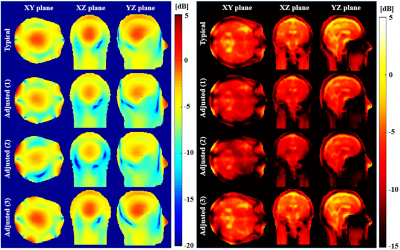 |
Effect on SAR and Transmit Efficiency by Geometrical Configuration of RF Transmit Head Coil for 7 T MRI
Youngdae Cho1 and Hyoungsuk Yoo1
1Electronic Engineering, Hanyang University, Seoul, Korea, Republic of
As the risk of RF heating in UHF MRI due to high specific absorption rate (SAR), recent work to design the coil focused to reduce SAR. In this study, the impact of the geometrical shape of the multi-channel RF head coil on the transmit efficiency (TE) and SAR efficiency (SE) was analyzed. Four different configurations of the head coil were simulated. it is evident from the results that a coil configuration similar to the head shape is required to optimize the TE and SE simultaneously.
|
|||
1576.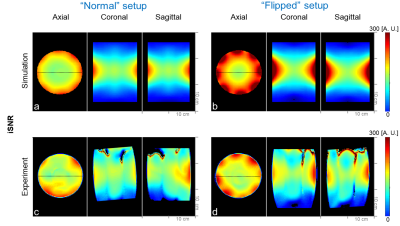 |
A dipole antenna array with “flipped” high dielectric constant (HDC) material for improved SNR at 10.5 Tesla
Myung Kyun Woo1, Lance DelaBarre1, Russell Lagore1, Steve Jungst1, Michael T Lanagan2, Thane Bonnett2, Qing X Yang2, Riccardo Lattanzi3, Kamil Ugurbil1, and Gregor Adriany1
1Center for Magnetic Resonance Research, Minneapolis, MN, United States, 2Penn state University, Centre County, PA, United States, 3Radiology at NYU Grossman School of Medicine, New York University, New York, NY, United States
In the previous work, we evaluated the transmit performance of 10.5 T RF coils composed of dipole antennas and high dielectric constant (HDC) ceramic materials with a “Normal” (Dipole - HDC - Sample) and a counterintuitive “Flipped” geometry (HDC – Dipole - Sample) positioning. Now we evaluated the receive performance of such an array structure with these setups both in simulations and experiments. The “flipped” setup showed notable periphery SNR improvement and suggest some promise for the UHF receiver arrays.
|
|||
1577.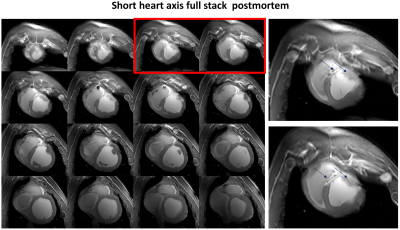 |
Development of a Dedicated Mono-surface 16-Element Transceiver Dipole Antenna Array for Parallel Transmission Cardiac MRI in Pigs at 7 Tesla
Ibrahim A. Elabyad1, Maxim Terekhov1, Michael Hock1, David Lohr1, and Laura M. Schreiber1
1Chair of Molecular and Cellular Imaging, Comprehensive Heart Failure Center (CHFC), University Hospital Wuerzburg, Wuerzburg, Germany
To improve parallel imaging performance for cardiac MRI in pigs at 7T, a dedicated transceiver 16-element antisymmetric dipole antenna array was developed and tested. EMF-simulations were performed with the antisymmetric dipole array loaded with a dedicated pig thorax-shaped phantom. Imaging performance of the dipole array was validated through MR-measurements in a pig phantom and an 85kg pig cadaver. The dipole array demonstrated a threefold improvement in coefficient-of-variation of the measured FA maps after $$${B_1^+}$$$-shimming using the vendor integrated pTx-platform. Parallel imaging with acceleration factor up to R=4 was possible while maintaining a mean g-factor of 1.13 within the pig heart.
|
|||
1578.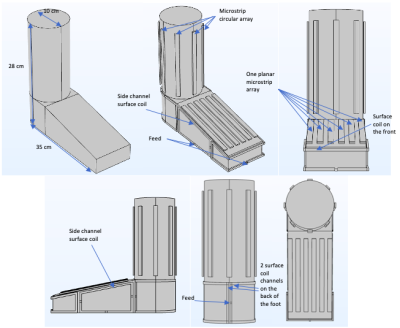 |
Design of a 19-Channel hybrid array system for Foot/Ankle Imaging at 7T
Aditya Ashok Bhosale1, Leslie L Ying1, and Xiaoliang Zhang1
1Biomedical Engineering, University at Buffalo, Buffalo, NY, United States
Microstrips are being used in MR applications due to their unique properties such as reduced radiation loss, high frequency capability, and reduced perturbation of sample loading to the RF coil compared to conventional coils. In this study, we propose a 19-channel hybrid array consisting of 14 Microstrips and 5 loop coils placed on the foot/ankle phantom to cover maximum area of the subject at 7T.
|
|||
1579. |
A 28-channel decoupled Tic-Tac-Toe transmit radiofrequency coil for 7T MRI
Tales Santini1, Anthony DeFranco1, Tiago Martins1, Andrea Sajewski1, Howard J. Aizenstein1, and Tamer S. Ibrahim1
1University of Pittsburgh, Pittsburgh, PA, United States
In this work, we investigated the potential of the smaller sizes of the Tic-Tac-Toe transmit coil elements, comparing the newly developed uncoupled configuration with the traditional coupled version of this RF coil design. Simulations with 14 Tic-Tac-Toe panels showed excellent levels of transmit field homogeneity at 7T (coefficient of variation = 12.6%, average = 0.28µT for 1W) while maintaining low levels of SAR (SAR efficiency = 1.41 µT/√(W/Kg)). The simulations were validated with phantom experiments. Future work includes the assembling of the 28-channel transmit coil and the investigation of the optimal power splitting strategy.
|
|||
1580. |
A Comparative Study Highlighting a Novel UHF MRI Volume Body Coil Design
Sayim Gokyar1, Henning U. Voss1, Victor Taracila2, Fraser J. L. Robb2, Douglas J. Ballon1, and Simone Angela Winkler1
1Radiology, Weill Cornell Medicine, New York, NY, United States, 2General Electric Healthcare, Aurora, OH, United States
We designed a novel 2D cylindrical high-pass ladder (c-HPL) volume body coil by adding a second dimension in S-I direction to the 1D birdcage concept, given that the latter fails at 7T body dimensions. We compared its performance to the (non-functional) 1D birdcage and transverse electromagnetic (TEM) designs. In silico results showed improved B1 homogeneity (inhomogeneity of 15.9%) with lower specific absorption rate (SAR) and better SAR efficiency (0.743 μT/W∙√kg). The proposed architecture is a promising candidate for UHF MRI applications where the current lack of a built-in body coil hinders the modality from gaining full clinical acceptance/approval.
|
|||
1581.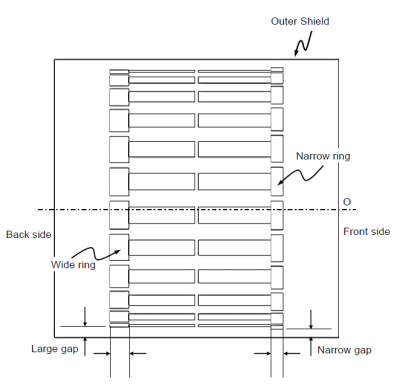 |
Asymmetric ring birdcage coil for volume excitation
Hideta Habara1 and Shinichiro Suzuki1
1Healthcare Business Unit, Hitachi, Ltd., Tokyo, Japan
Design of asymmetric ring diameter birdcage volume coil has been studied by electromagnetic filed simulations. Even if the diameter of the front and the rear rings of the birdcage coil is changed to some extent with respect to the cylindrical RF shield, the uniformity in the Z direction can be maintained by changing the width of the front and rear rings. Increasing the gap between the ring and the RF shield has an advantage in efficiency even applied on one side of the ring.
|
|||
1582.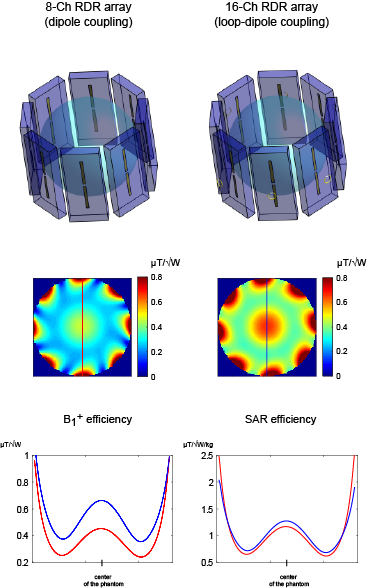 |
Toward Enhanced Transmit Performance of Rectangular Dielectric Resonator Antenna Arrays for 7-T MRI Using Loop/Dipole Coupling Scheme
Daniel Wenz1,2
1CIBM Center for Biomedical Imaging, Lausanne, Switzerland, 2Animal Imaging and Technology, Ecole Polytechnique Federale de Lausanne (EPFL), Lausanne, Switzerland
This study investigates a loop-dipole coupling scheme as a new approach to excite orthogonal dielectric modes in a rectangular dielectric resonator antenna for MRI at 7T. A rectangular dielectric resonator antenna was simulated, built and its performance was evaluated in phantom experiments using two coupling schemes: dipole-only and loop-dipole. It was found that the loop-dipole coupling scheme can substantially enhance not only transmit performance of a single element, but also of an array of rectangular dielectric resonator antennas (transmit field efficiency gain of 35%).
|
|||
1583.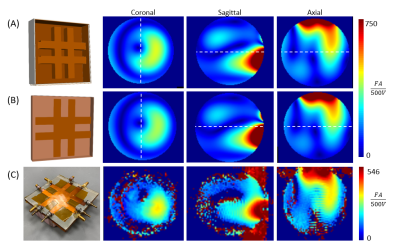 |
Development of a Microstrip Tx Coil Module for 7T MRI
Andrea N Sajewski1, Tales Santini1, Matthew Saich1, Tiago Martins1, and Tamer S Ibrahim1
1University of Pittsburgh, Pittsburgh, PA, United States
A 7T microstrip RF coil was designed based on the Tic-Tac-Toe (TTT) concept that has previously shown homogeneity and load-insensitivity. Simulations were performed to compare B1+ distributions between the microstrip TTT and standard TTT coils. A 4-channel microstrip coil was assembled and B1+ maps were acquired at 7T. Nearly equivalent B1+ distributions were observed, indicating the potential for using a highly dense microstrip array to provide excellent homogeneity and reduction of SAR while enabling unique designs, such as conforming to the anatomy of interest.
|
|||
1584.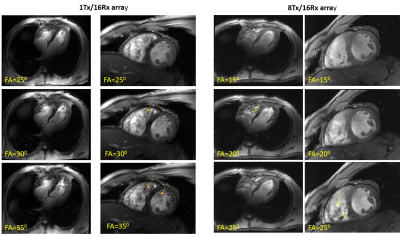 |
New commercial 8Tx/16RX array for Clinical 7T Cardiac MRI: initial experience
Maxim Terekhov1, David Lohr1, Theresa Reiter2, Ibrahim A. Elabyad1, Michael Hock1, and Laura M. Schreiber1
1Chair of Molecular and Cellular Imaging, University Hospital Würzburg, Comprehensive Heart Failure Center, Wuerzburg, Germany, 2Department of Internal Medicine I, Cardiology, University Hospital Würzburg, Wuerzburg, Germany
7T cardiac MRI is a novel field with the potential to increase the physical sensitivity and diagnostic value of the clinical cardiac images. Multiple elements transmit/receive phased array coils in combination with parallel transmit RF-technology allow for an improvement of the image quality at ultra-high-field (B0≥7T) field strength. In this work, we present initial experience with a new commercial 8Tx/16Rx thorax array coil operating in a “pTX-Compatibility Mode” of the scanner for cardiac MRI at 7T.
|
|||
1585.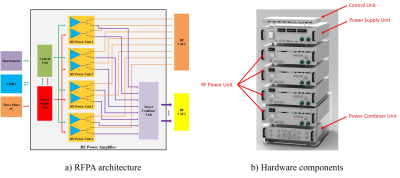 |
High power RF amplifier for UHF MRI with configurable number of channels
Jifeng Chen1,2, Ye Li1, Han Zhang2, Bin Cao2, Xin Liu1, Hairong Zheng1, and Xu Chu2
1Lauterbur Imaging Research Center, Shenzhen Institutes of Advanced Technology, Chinese Academy of Sciences, Shenzhen, China, 2United Imaging Healthcare, Shanghai, China
Increasing magnetic field strength can improve signal-to-noise ratio (SNR) of MRI [1] and it requires higher power capability and fidelity from RF Power Amplifier (RFPA). Meanwhile, to reduce B1 inhomogeneity at high field usually requires multi-channel parallel transmission (pTx) technique. In this study, we present a method to design RFPA with high power capability and output linearity, and with configurable number of transmit channels so as to meet different RF coil and load requirements.
|
|||
1586. |
Quadrature Tx/Rx wireless coil for targeted breast MRI at 1.5 T
Viktor Puchnin1, Anna Hurshkainen1, Anton Nikulin2, Georgiy Solomakha1, Anna Andreychenko1,3, and Alena Shchelokova1
1Department of Physics and Engineering, ITMO University, St. Petersburg, Russian Federation, 2Institut Langevin, ESPCI Paris, CNRS, PSL University, Paris, France, 3Research and Practical Clinical Center for Diagnostics and Telemedicine Technologies of the Moscow Health Care Department, Moscow, Russian Federation
We demonstrate for the first-time a quadrature transceive wireless coil for 1.5T targeted breast MRI. The proposed concept features two volumetric resonators: metamaterial-inspired structure and Helmholtz coil. These coils are electromagnetically coupled to the body birdcage coil and interact with its magnetic field’s components, thus boosting body coil transmit efficiency, SAR efficiency, and receive performance for the targeted area of the human breast.
|
|||
1587.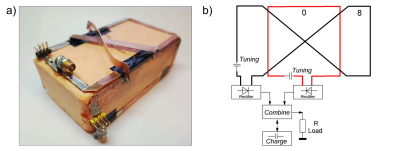 |
Circularly polarized coil for 1.5 T MRI RF harvesting
Pavel Seregin1, Georgiy Solomakha1, Egor Kretov2, Oleg Burmistrov1, and Alexey Slobozhanyuk1
1The Department of Physics and Engineering, ITMO University, Saint Petersburg, Russian Federation, 2Max Delbruck Center for Molecular Medicine in the Helmholtz Association, Berlin, Germany
The concept of the wireless power supply for the MRI coils demands high efficiency in a restricted volume. To meet these requirements, we investigated the possibility of harvesting the energy from the B1 field of a 1.5 T MRI scanner using a new volumetric coil design. We performed a series of experiments with the different positions of the proposed coil within the scanners bore and estimated the accepted power levels during the different types of MR pulse sequences.
|
|||
1588.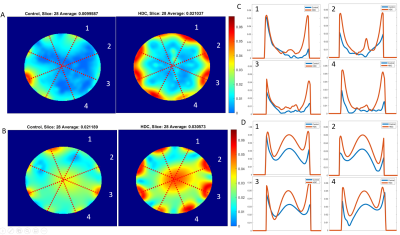 |
Development of Microstrip Coils Integrated with High Dielectric Constant (HDC) Material to Improve B1 Field and Performance of 1H MR imaging at 7T
Soo Han Soon1,2, Matt Waks1, Xiao-Hong Zhu1, Hannes M. Wiesner1, Navid P. Gandji3, Qing X. Yang3, Michael T. Lanagan4, and Wei Chen1
1CMRR, Department of Radiology, University of Minnesota, Minneapolis, MN, United States, 2Biomedical Engineering, University of Minnesota, Minneapolis, MN, United States, 3CNMRR, Department of Neurosurgery, Penn State University, Hershey, PA, United States, 4Department of Engineering, Penn State University, Hershey, PA, United States
The development of ultra-high-field (UHF) magnetic resonance imaging (MRI) and spectroscopy imaging (MRSI) technologies improves sensitivity and spatial resolution for biomedical and clinical applications. However, the limited inherent signal-to-noise ratio (SNR) is still challenging, especially for pushing spatiotemporal resolution even at UHF. Previous studies have shown that high dielectric constant (HDC) materials could provide a new RF engineering solution for the challenge. In this study, we introduce a novel microstrip transmission line (MTL) transceiver array that uses HDC material as substrate, and significantly improves the RF transmission (B1+) and reception (B1-) fields and SNR for 1H imaging application at 7T.
|
|||
1589.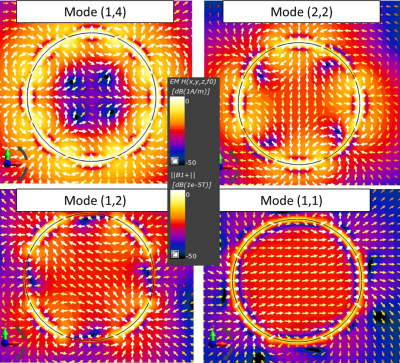 |
A 2D High-Pass Ladder RF Coil Architecture for UHF MRI
Sayim Gokyar1, Henning U. Voss1, Victor Taracila2, Fraser J. L. Robb2, Michael Bernico3, Douglas Kelley3, Douglas J. Ballon1, and Simone Angela Winkler1
1Radiology, Weill Cornell Medicine, New York, NY, United States, 2General Electric Healthcare, Aurora, OH, United States, 3General Electric Healthcare Technologies, Waukesha, WI, United States
We propose a two-dimensional cylindrical high-pass ladder (2D c-HPL) volume coil architecture as a new class of radiofrequency coils to be used for 7T Body MR imaging. As a first simplified experimental proof-of-concept we show feasibility in a head sized coil. In silico results show 45% more homogeneous B1 field distribution with 25% lower specific absorption rate compared to a similar size birdcage coil. Experimental results are in good agreement with theory and numerical simulations. The proposed architecture shows promise to solve the longstanding open challenge of volume coil B1+ inhomogeneity in UHF MRI applications.
|
|||
1590.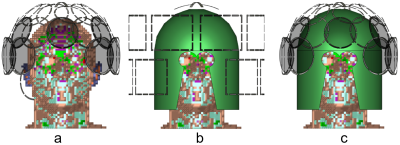 |
Performance comparison of using an external 16-channel transmit array vs. using 16 elements of a 32-channel receive array as transceivers at 10.5 T
Bei Zhang1, Gregor Adriany2, Navid Pourramzan Gandji3, Qing X. Yang3, Brian Rutt4, Jeramie Radder2, Lance DelaBarre2, Myung Kyun Woo2, Kamil Ugurbil2, and Riccardo Lattanzi5,6
1Advanced Imaging Research Center, UT Southwestern Medical Center, Dallas, TX, United States, 2Center for Magnetic Resonance Research, Department of Radiology, University of Minnesota, Minneapolis, MN, United States, 3Department of Radiology, Pennsylvania State College of Medicine, Hershey, PA, United States, 4Department of Radiology, Stanford University, Stanford, CA, United States, 5Center for Advanced Imaging Innovation and Research (CAI2R) and Bernard and Irene Schwartz Center for Biomedical Imaging, Department of Radiology, New York University School of Medicine, New York, NY, United States, 6The Vilcek Institute at NYU Langone Health, New York, NY, United States
Shielding effects associated with surrounding the receive array with an external transmit (Tx) array could decrease the signal-to-noise ratio (SNR) at 10.5 T. Two Tx approaches were compared: using 16 receive elements as transceivers vs. using a 16-channel external transmit array. For both cases, the effect of using high-permittivity material (HPM) was evaluated. Our simulation results showed that performance was larger for the transceivers and further increased with HPM. This suggests that the additional complexity associated with constructing a multi-element transceiver array compared to using an external transmitter could be justified for 10.5T imaging by the expected gain in performance.
|
The International Society for Magnetic Resonance in Medicine is accredited by the Accreditation Council for Continuing Medical Education to provide continuing medical education for physicians.